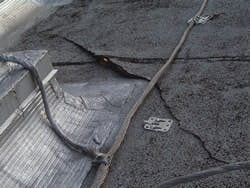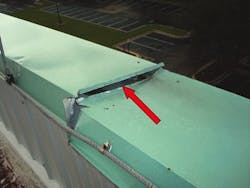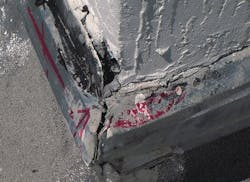By Samuel Chiodo
We've all heard people say that you have to spend money to make money; however, in today's uncertain economic times, companies across the country aren't just looking to make money - they're tightening their belts, battening down the hatches, and looking for ways to save money. But, even during hard times, it's important to remember that the old "spending" adage can still hold true for savings; sometimes you have to spend money to save money, especially with regard to a building's roof.
Although they are perhaps the least visible portion of buildings, roofs can account for up to 50 percent of a building's total surface area, and they can represent up to 25 percent of total building value. By proactively investing resources in building and maintaining a solid roof, building owners may extend the lives of their 15-year roofs to 25-year roofs by heading off leaks and other adverse conditions, which translates into significant long-term cost savings.
Roof Disarray
Roof inspections focus not just on the quality of the work installed, but also on the complete roofing project. This means that inspectors not only review how well the roofing contractor installed the work, but they also look at how the other trades have treated the roof in progress or completed installation.
Consider the case of a condominium building in Florida. The roofing contractor was a reputable firm, known for quality work. The initial and midpoint inspections revealed a quality roof installation, with good workmanship, industry-standard terminations, and tight flashings.
During construction, however, the roof system cap sheet was unprotected and exposed to a multitude of staging equipment and debris by other subcontractor trades. Later inspections revealed that counter flashing and base flashing terminations had been damaged, and stucco residue had been left to harden on the field membrane. As a result of this extensive surface damage, the warranty was withheld until the roof surface was recoated as required by the manufacturer.
Because the roofing consultant kept inspection records throughout the building process, it was easy to see that damages were not due to negligence on the part of the roofing contractor. Instead, the general contractor back-charged the cost of cleaning the roof and repairing damages to the subcontractors. Once damages were repaired, the roof manufacturer was able to provide a warranty.
Preventive investment in the life of a roof happens in two primary areas: during the construction process of a new building, or as preventive maintenance for an existing roof. The goal of each is to extend the life or primary envelope function of the roof, but the different stages require two different types of oversight.
New Construction
Like any area of construction, from glazing to structural engineering, roofs require unique expertise to maximize their effectiveness. Having an expert involved during the building's design, all the way through construction, can ensure that the roof is designed, engineered, fabricated, and assembled to provide the building and its contents with watertight protection.
The optimal time to get a roof expert involved in the construction of a building is during the design phase, while the architectural team is still working on its detailed plans. A pre-design meeting between the owner/developer, architect, and roofing expert can help highlight issues that architects may need to address in the design - especially issues that may be unique to a particular climate.
An architect designing in South Florida, for example, will need to plan for stronger attachment of all roof components due to calculated uplift pressure requirements outlined in hurricane-related building codes. In northern climates, though, considerations must be made for snow weight and removal, ice dams, and the expansion and contraction associated with building materials in extreme climates. In either situation, it can be helpful for an architect to have a roofing expert available to alert him/her to potential issues before they arise.
As the design progresses, the roofing consultant should review architectural drawings and CSI Division 7 specifications related to waterproofing and roofing. The goal here is twofold: to ensure that the architectural team designs and specifies a roofing system that will adequately protect the building, and to ensure that the drawings and specifications are detailed and accurate enough for the general contractor to obtain accurate bids from roofing subcontractors. Accurate and detailed drawings at this stage can prevent the necessity of time-consuming architectural drawing changes and costly rebids or bid-change orders later in the building process.
In general, the roof expert will be looking at the design drawings and specifications for things like:
-
Membrane components and flashing. Are the appropriate membrane and flashing specified for the design, and do they reflect the specifications manual?
-
Detailed method of attachment. How the roof is attached is a major factor in its longevity and effectiveness. Do the design drawings provide adequate details and specifications relating to the geographical location?
-
Product compatibility. Just like any construction application, some products work together; some don't. For example, most silicone sealants can't be painted, and spray foam and asphalt products never go together. The consultant will assess compatibilities. Will the specified roof-system products that intersect with other subcontractor products (e.g. a glass and glazing curtainwall) work together?
-
Sequencing of installation. Roofing layers must be applied in a certain order, depending on the system, to maximize effectiveness. Do designs call for the right sequence?
-
Overall layout. Certain areas of a roof, such as those where HVAC units are located, will have higher foot traffic and maintenance-activity requirements. This should be accounted for in the roof design, with traffic and protection pads to protect the roof membrane and waterproofing materials. Is there enough protection in the right places?
Coping impact damage should be looked for during quality-assurance inspections.
Product Submittals
After a roofing contractor has been selected, the contractor must submit full specifications for the system and all the components he/she intends to use. The roofing consultant should review these submittals to ensure that they coincide with the original specifications, and to be sure all details are appropriate for the system and the climate.
One common mistake in many projects is specification of the wrong type of fasteners. For example, roofing subcontractors for projects in coastal Florida may propose using galvanized screws to secure flashing; however, in Florida, the salt air will rust galvanized screws, so a roofing consultant would call out his or her recommendation to use stainless steel. It's a small detail, but it can have tremendous impact on the life of a roof and the necessity of future repairs.
Pre-Installation Conference
Many of the various subcontractors involved in a building project will require roof access at some point to complete their portions of the building. Many may actually need to penetrate the roof to install pipes, vents, conduits, or machinery. To coordinate these efforts and ensure that they don't cause damage to the roof, a pre-installation conference should be a top priority.
At this meeting, the roof consultant will sit down with the architect, general contractor, roof manufacturer, and any subcontractors whose work may impact the roof to coordinate schedules and plans. This conference can also help determine where extra roof protection pads may be needed.
"Another issue we often address is the spacing and separation of all roof penetrations," says Jon B. Blehar, an architect in Lake Worth, FL. "We need to be sure that all pipes, vents, and conduits are spaced far enough apart that they leave enough room for the roofers to properly flash them. Lack of proper flashing can cause leaks and may affect the roof manufacturer's warranty."
Quality-Assurance Inspections
After all plans, submittals, and products are approved, and the actual work begins, quality-assurance inspections should be conducted at various points throughout the installation. The number of inspections varies from as few as two to as many as eight to 12, depending on the project. Four is a good guideline: one at the beginning to be sure everything is off to a good start, one in the middle as a progress check, one toward the end, and a punch-list inspection at the very end.
Common problems encountered in these inspections include everything from waterproofing seam failures to damaged flashing and debris left on the roof. See Roof Disarray, below, for an example of one project's inspection finds. The ultimate goal is a secure building envelope and a watertight roof that's in accordance with required codes and specifications.
Bad terminations and other surface problems that occur during construction can cause the roof manufacturer to withhold the warranty until damages are repaired.
Preventive Maintenance: Roof Asset Management
All roofs have a limited lifespan and will eventually require replacement, retrofit, repair, or restoration. Whether a roofing consultant was involved in the construction of the building or not, developing a preventive maintenance plan can further extend the life of a roof and save money by correcting problems before they become major leaks that could cause structural damage. Over time, a roof asset management program can optimize roof performance, save money, and allow for roof replacement or repairs on a planned basis - not in reaction to a crisis.
If a roof is new and has been inspected by a roofing consultant throughout construction, the final inspection report should provide enough information to establish a maintenance plan and inspection timetable.
For an existing roof, a consultant should thoroughly inspect the roof and provide a written report of findings with a photo survey of roof conditions for future reference. Based on those findings, the consultant will develop projected life-cycle budget cost estimates and establish plans for upcoming maintenance, replacement, or repair.
From this point, a good roof-management program should include annual inspections for an inspector to look for damage, including:
-
Membrane deterioration.
-
Water blisters.
-
Ponding water.
-
Coping impact damage.
-
Rusting metal.
-
Spray foam oxidation.
-
Membrane split.
If the roof shows signs of deterioration, the consultant may recommend moisture testing, such as:
-
Moisture probes, which are used to check distressed areas for the presence of moisture by probing through the roof surface and taking readings from the moisture meter.
-
Infrared scans, which are infrared snapshots of a roof area taken to detect the possible presence of moisture by recording temperature differentials.
-
Nuclear scans, which utilize a roof grid survey to detect subsurface moisture.
-
Roof cores, where an investigative hole is cut through the roof and insulation to document conditions in suspect areas. This hole is patched upon completion.
Ultimately, the goal of both new construction roofing review and ongoing roof-management programs is to protect the interest of building owners, extend the life of the roof, and prevent costly leaks and damage. In today's business climate, many building owners and businesses are understandably looking for ways to cut costs; however, involving a roofing consultant in construction or an ongoing maintenance program will end up saving you more than you spend.
Samuel Chiodo is a roof specialist at West Palm Beach, FL-based Glazing Consultants Intl. LLC.





